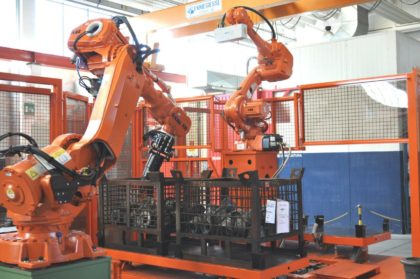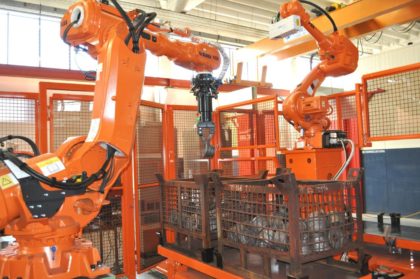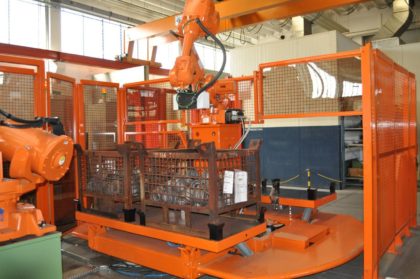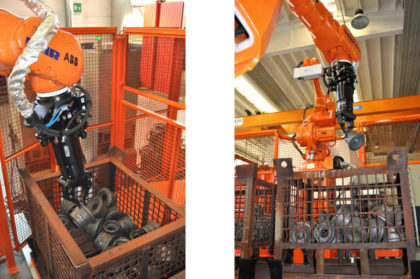Thanks to the new 3D CubicVision system, SIR Soluzioni Industriali Robotizzate finally solves the problem of bin picking, transforming technology into genuine artificial intelligence.
THE IMPORTANCE OF THREE-DIMENSIONAL VISION
The last few years have witnessed the adoption of artificial vision applied to robotics in industry on a vast scale. Amongst the system integrators who have pursued this route, SIR Robotics for Industry (Modena, Italy) has been particularly impressive, due to both its wealth of know-how and the complexity of the 2D and 2½D solutions offered. But the final step, a user-friendly, universal, multi-purpose three-dimensional vision system with a broad spectrum of applications, was still missing. This has led to the birth of CubicVision, the missing link for achieving the dream of the automatic factory: thanks to its use, the picking of pieces arranged at random inside a container is finally possible.
THE HEART OF CUBICVISION
The SIR solution is a truly three-dimensional vision system, capable of guiding the robot into the correct angles and spacial coordinates, allowing secure, precise pickup in every situation. But what we are talking about is not just a component, but a tool perfectly integrated with the robot itself. Any type of manipulator can be interfaced with the system by means of special algorithms that give the machine real decision-making capacity. Revolution and evolution merge in a product whose substance can be summarised in just one simple word: flexibility of use. Thanks to its general purpose characteristics, the CubicVision system is modular and versatile, capable of adapting to the many different needs and offering the best solution for the specific application, regardless of the shapes and sizes of the objects for picking or the different application scenarios.
CUBICVISION APPLIED TO THE PRODUCTION OF EARTH-MOVING MACHINERY COMPONENTS
One of SIR’s most interesting applications is the development of handling systems for a well known producer of earth-moving machines used in road-building or mines and quarries. The parts for manipulation are the halves of the rollers installed inside crawler tracks: these are components with complex shape, varying in weight and size but weighing of the order of several dozen kilos. The application tends a welder with two loading positions, where the right and left halves of the roller are welded together to produce the finished piece. In this case, the problem of feeding is of fundamental importance: if a conventional solution is used, the weight and size of the pieces mean that operatives have the strenuous task of removing them from the bins using a hoist and then loading them onto the feeding belts. Apart from the problems of the physical effort and risks involved, the use of conveyor belts reduces the plant’s autonomy.
Use of the CubicVision system has solved these problems by allowing the pieces to be picked automatically from the right-hand and left-hand bins. The bins are arranged on an indexing table which conveys them into the robotic system. The first key element in the application is installed on the table, on a raised stand: it is a robot carrying a sheet-of-light sensor, comprising a camera and a laser source. This robot takes care of the localisation phase: by performing scans in various directions and at varying heights, it acquires three-dimensional images consisting of clouds of points in space, which are sent to a central PC.
The 3D algorithms resident on the PC identify the objects in the bins regardless of their position: the perspective matching is able to recognise pieces turned or upside-down pieces without hesitation, with a very short processing time. It takes just a few seconds to program a new piece: the user simply downloads the CAD model of the roller half into the application and the program will automatically adapt to the new piece to be localised.
Once it has received the images, the system calculates which of the possible candidate objects can be picked up safely, on the basis of relative heights, absence of overlapping between adjacent elements, angles in space and risk of collision with neighbouring components or the edges of the bin. This generates different picking options: on the inside holes, on the outside diameters or on the shank.
A second robot now steps in to perform the picking operation as such: the difficulties intrinsic to three-dimensional vision lie not only in localisation but also in achieving a reliable, precise, absolutely safe grip. SIR has therefore also done a great deal of work on mechatronics, producing a hydraulically operated end-effector with special features capable of picking up partially occluded roller halves placed vertical on the edges or in the corners of the container. This solves the problem of emptying the bin, which is installed on a system that gradually tilts it towards the robot, to prevent heaps of pieces from building up.
Once a roller half has been picked up, precision positioning is required before it is inserted in the machine. Because of its weight, the roller half may shift on the gripper during picking, especially if it rubs against an adjacent piece or is partially occluded. Pieces are repositioned on a V-shaped locator, which can open and close to slide the piece into a known position. This position is checked by a 2D vision system which then informs the robot of the correct picking coordinates. The re-aligned pieces are placed on a parking zone ready for feeding into the welder. The robot now changes its gripper, collecting a pneumatic end-effector from a magazine. The next step is to unloading the finished piece from the machine and place it on the exit conveyor belt. The machine is then loaded with the new unfinished roller halves and the end effector is changed before returning to the bins, where a new localisation process will have taken place in the meantime.
THE DREAM COMES TRUE
Impressive in itself, this application opens out new horizons in the field of robotic automation. CubicVision makes the dream of gripping objects of any shape, size and material placed loose inside any container come true. This achievement has given access to a range of previously unthinkable industrial applications, where the possibility of three-dimensional observation becomes an absolute necessity: a major technological revolution, really capable of transforming automation into intelligence.
Davide Passoni
R&D Department
SIR spa






